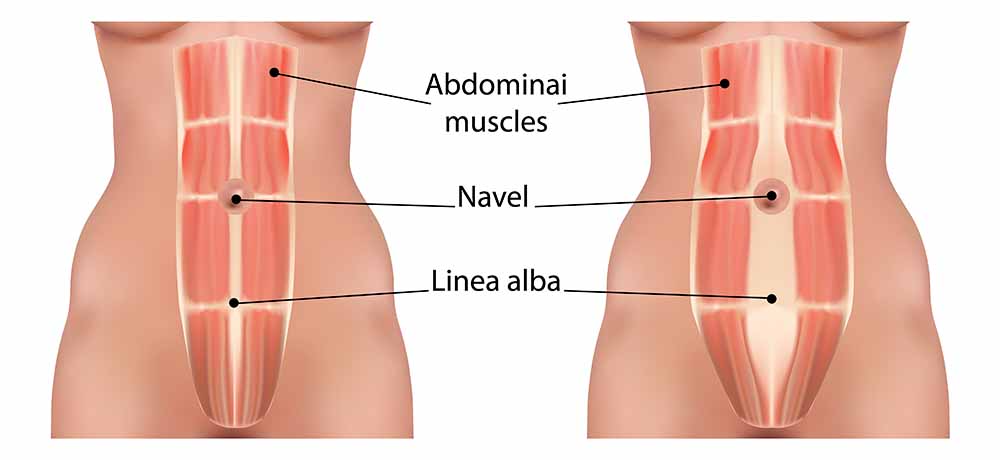Tips To Reduce The ‘Mum Tum’ (And Why It's So Hard To Shift)

When it comes to postpartum fitness, it's common for mums to jump straight back into things to lose weight and 'bounce back' quickly. However, all those jumps, push ups, planks and crunches you'll find in mainstream exercise classes may actually be making your mum tum worse.
Unfortunately there is a lot of misinformation amongst both exercise professionals and gyms as it's only relatively recently that postpartum recovery has been seen as something that should be treated differently. We shouldn't just be slipping back into what we were doing before we were pregnant (and if you did, you may have skipped a step of your recovery!).
Stubborn mummy tummy that won't shift can often be a combined result of core weakness, hormones and nutrition. Learn why this is about more than just losing body fat and what you can do about it.
What is diastasis recti?
One of the key causes of mummy tummy is diastasis recti - the separation of the abdominals muscles down the centre at the front of your body. This is completely normal during pregnancy to accommodate growing baby, however, if it doesn't come back together on its own or you do exercises that aggravate the condition, it can leave you with a weakened core potentially years down the track. Many women don't even realise they have diastasis recti until they get assessed for pelvic floor dysfunction or lower back problems later.
A small gap (2cm or less) may not be an issue, it's more about the strength of the connective tissue - the linea alba - as well as the underlying muscles, and whether they're capable of maintaining the pressure in your abdomen while you're training and going about your everyday life. If they're not strong enough, you may notice coning or doming in your belly, or a mum tum 'pooch' in this area.
Because of this, whether you're a few weeks postpartum or it's been 20 years since having a baby, it's still a good idea to get checked by a knowledgeable women's health physiotherapist (even better if they are a pelvic floor physio too) so they can do a proper assessment for you and your unique needs.

Pressure and loading
Think of your abdomen as a pressure canister. At the top we have a thin layer of muscle called the diaphragm that sits just under your lungs. At the front, back and sides there are your abdominal muscles (including your transverse abdominis all the way around your belly like a corset, obliques at the sides and rectus abdominis at the front). At the bottom are your pelvic floor muscles.

If any point is weak due to stretched muscles, overly tight muscles or imbalances, this is where we end up with a problem as the pressure ends up leaving the body through the weakest points - potentially resulting in coning/doming or pooching in the centreline of the belly, incontinence issues, pelvic organ prolapse or hernias.
When we inhale, we want this 'canister' to expand evenly in all directions outwards, and when we exhale, it should move inwards evenly from all directions. This makes breathing (and not 100 hours of crunches and planks) the perfect start to start exercising more safely. Breathing may seem simple, but so many people have trouble doing it right!
Give it a go
TRY IT: When was the last time you connected with your breath? Start by sitting or standing tall - lengthen through your spine as if your hair was in a ponytail and someone was pulling it straight up at the back. Stack your ribs over your pelvis and try to fully relax your body in this position - soften your shoulders, release your jaw. We need to be able to take a full inhale that feels like it goes right down to our pelvic floor and expands our ribcage out in all directions (front, back and to the sides of your body). On the exhale we are aiming to feel all sides of the pressure canister gently move back towards the centre of your body with a gentle lift in your pelvic floor muscles at the same time (i.e. not bearing down or feeling heaviness). This is called 360 degree or diaphragmatic breathing and is the basis of how you should be breathing normally.
Some women may grip down through the ribs - super common especially in athletic women, ladies who feel very stressed as well as those who do Pilates-style core work - so if you think that might be you, try placing your hands on the sides of your ribcage to feel for the expansion on all sides.
Mum tum in the lower belly can often be caused by the lower transverse abdominals not engaging correctly, so focus on getting that good deep breath down into your lower tum and feeling the slight contraction - especially just above the hip bones - in the same area as you exhale.
Our core and pelvic floor connected
So now we know that mum tum is often linked to weakness in the core muscles; another issue that can go hand-in-hand with this is pelvic floor problems. Remember that these muscles form the base of the pressure canister, so these aren't separate problems.
Leaking and feelings of heaviness can be common after having a baby, but it's not normal so we shouldn't just put up with it! There are many exercises and strategies you can use to help alleviate this issue - there are general tips in our Postnatal Return To Exercise programme, but again it's best for you to see a pelvic floor physio if possible.
Kegels aren't always the answer as some women may leak due to tight pelvic floor muscles (which means kegel exercises will make things worse); being able to fully relax your pelvic floor is just as important as being able to contract it.
It's important not to ignore leaking because what seems like a small issue now may worsen later in life. When we reach menopause, the hormonal changes cause tissues to thin, so it's becoming increasingly common for light bladder leakage to worsen potentially even causing prolapse around this time.
Exercise tips: What to avoid
It's important to treat this with a rehabilitation approach - this doesn't mean you won't be lifting heavy weights or sitting out on crunches forever! We're playing the long term game here, so make your goal to educate yourself and nail the techniques so you can get stronger quicker with less risk of injuring yourself.
Exercises that may make things worse and we would recommend to avoid include:
- Planks, hovers - sustained bracing movements that put a lot of internal pressure on your core muscles. Instead, elevate the front of your body and do them up against a wall or kitchen bench top.
- Crunching movements - can worsen diastasis and/or over-work the rectus abdominis (another cause of mum tum). This includes sit-up style movements in your everyday life such as getting out of bed or off the couch. Substitute by rolling off to the side then standing.
- Push ups - for the same reason as hovers and planks. Again, elevate the front of your body by doing push ups against a wall or bench top.
- Lifting heavy weights - obviously if you have older children that you still need to pick up, this may be a little tricky! Learn how to handle the abdominal pressure when you lift heavy by starting with smaller weights, using your breath with the movement to control pressure, and going heavier over time. Use the same techniques when picking up kids, the groceries etc.
Exercise tips: What to work on
These may feel like a step back from what you've been doing, be patient with the process and know that you're on the right track!
- Deep breathing into the belly, back and sides (not up into your shoulders) without bearing down and full relaxation on the exhale with a gentle lift of the pelvic floor.
- Good posture - poor posture can affect the healing of your diastasis and mum tum appearance. Think of stacking your ribs over your pelvis, try to stand and sit without slumping or poking your head forwards. Lift up tall through your spine and the back/top of your head.
- Pilates-style core work beginning on your back or side lying, progressing to all fours, then 3/4 position and finally full plank work (includes push ups). Aim to nail your breathing technique, alignment and posture with every exercise and progress to harder versions once it feels like second nature and you can control your abdominal pressure.
- Reduce stress - when we have high levels of cortisol (stress hormone) in our body, we can retain body fat around the tummy. Get plenty of sleep, do things that make you feel happy and calm, stretch, meditate.
- A balanced routine that works your whole body, including mobility and stretching.
Nourishing nutrition and bloating
Belly bloating can often be a result of our nutrition - even if you eat healthy foods, it's becoming increasingly understood that just because a food is healthy doesn't necessarily mean it's right for you. Pay attention and see how your body feels after each meal.
If you feel bloated, sluggish, experience excessive gas, diarrhoea or constipation, it's a sign your body isn't tolerating a food well. Try and isolate what's not working for you with a food diary.
Another element of mum tum can be body fat, and this is an area we tend to store it when we have extra energy from food that we haven't used up. To reduce this, it comes down to moving your body and using up more energy/calories/kilojoules than you're taking in through what you're eating. This is why working with your body and focusing on having the energy to get moving often, as well as nourishing yourself with quality foods in the right portion sizes is also important.
Finally, make sure you drink plenty of water and limit your salt intake. This will help ensure your body stays hydrated and reduces holding onto excess water.
Manage your expectations
Regardless of what anyone may try to tell you, your body is different after pregnancy - maybe forever - and that's okay. Take it slowly and learn to be okay with scaling things back to a walk or lower impact exercise until your body is strong enough to handle more intense workouts.
If you're still newly postpartum, throw into the mix sleepless nights, hormone fluctuations, higher stress levels and if you're breastfeeding, extra calorie needs and potentially ravenous hunger - it may be some time before you can establish a regular training routine that's in line with the goals you want to achieve. There's plenty of time in your life to push yourself later, use the early days to connect with baby, recover and rehabilitate, and nourish your body.
Images / DepositPhotos.com









